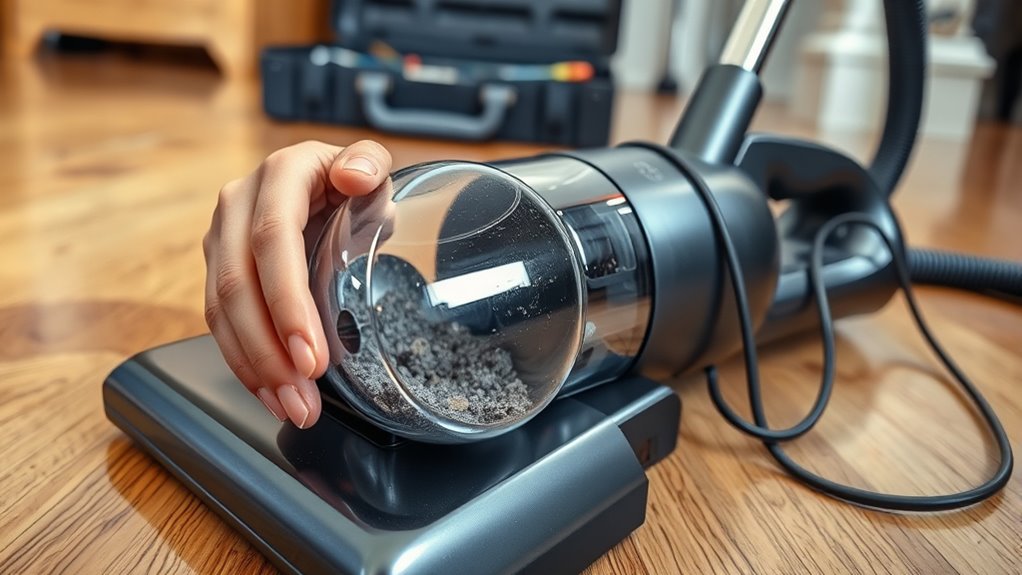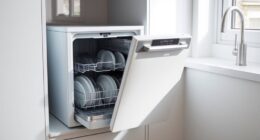When you’re hearing strange noises from your vacuum, like a squeal, rattling, or humming, it’s time to investigate. A high-pitched squeal usually means a worn or misaligned belt, while rattling can indicate loose parts. A low hum might suggest airflow blockages or a struggling motor. It’s vital to check for clogs and make sure all components are secured. Address these issues promptly to keep your vacuum running smoothly and efficiently. Learn more about specific noises and their solutions.
Key Takeaways
- A high-pitched squeal often indicates a worn or misaligned belt that may need replacement.
- Rattling sounds suggest loose parts or screws; check both externally and internally for secure fittings.
- A low, humming noise typically points to motor strain caused by airflow obstructions; inspect hoses and filters for clogs.
- Popping or clicking noises could signal electrical issues; consult a professional if basic troubleshooting fails.
- Regular maintenance, including cleaning filters and inspecting belts, helps prevent strange noises and prolongs vacuum life.

When your vacuum starts making odd noises, it can be frustrating and concerning, especially if you rely on it for keeping your home clean. You might hear a variety of sounds, but understanding what they mean can help you diagnose the problem before it becomes a costly repair or replacement. One common issue is a belt squeal, which usually indicates that the belt connecting the vacuum motor to the brush roller is worn out or misaligned.
If you notice a high-pitched squeal when you turn on your vacuum, it’s likely the belt trying to work harder than it should. This can happen if debris has jammed the brush roller or if the belt itself has stretched over time. To address this, first, unplug your vacuum for safety. Then, check the brush roller for any clogs or tangles. Remove any hair or debris you find, as these can prevent the roller from spinning freely. If the belt appears damaged or worn, replacing it is often a straightforward process.
Another noise to pay attention to is a rattling sound, which might suggest that something is loose inside the vacuum. This could be a loose screw or a component that has come detached. Start by inspecting the vacuum’s exterior for any visible signs of damage or loose parts. After that, open the vacuum casing if you’re comfortable doing so, and check for anything that might be rattling around. Tightening screws or reattaching loose components can often solve the problem.
If you hear a low, humming noise that doesn’t seem quite right, it could indicate that the vacuum motor is struggling. This may be caused by a clog in the hose or filter. A blocked airflow can overwork the motor and lead to overheating, which can damage it over time. To fix this, inspect all air pathways. Clean or replace filters as needed, and ensure that hoses aren’t kinked or blocked.
Finally, if you hear a popping or clicking noise, it might be a sign of an electrical issue or a problem with the motor itself. If basic troubleshooting doesn’t resolve the issue, it might be time to consult a professional. Regular maintenance can prevent many of these problems, so always keep an eye on your vacuum’s performance to ensure it’s running smoothly. Taking these steps will help you keep your vacuum in top shape, ensuring your cleaning routine remains hassle-free. Additionally, understanding the importance of regular maintenance can significantly extend the life of your vacuum cleaner.
Frequently Asked Questions
Can I Use My Vacuum on Wet Surfaces?
You shouldn’t use your vacuum on wet surfaces. Most vacuums aren’t designed for moisture, and doing so can damage the motor or create safety hazards, like electrical shocks. If you need to clean up spills, consider a wet/dry vacuum specifically built for that purpose. Always prioritize vacuum safety to make sure both your appliance and your well-being stay intact. Stick to dry surfaces for regular vacuums to keep everything running smoothly.
How Often Should I Replace My Vacuum Filter?
You should replace your vacuum filter every 6 to 12 months, depending on your vacuum model and usage. Regular vacuum filter maintenance helps guarantee peak performance and air quality. If you vacuum frequently or have pets, you might need to replace it more often. Create a filter replacement schedule to keep track of this essential maintenance task, ensuring your vacuum runs efficiently and lasts longer. Don’t forget to check the filter regularly for signs of wear!
Is It Safe to Vacuum Pet Hair?
Yes, it’s safe to vacuum pet hair as long as your vacuum’s designed for it. Most modern vacuums effectively handle pet hair removal without damaging your floors or causing clogs. Just make sure to clean your vacuum regularly to maintain its efficiency. If you notice any strange noises while vacuuming, it might indicate a blockage or a need for maintenance. Keep an eye on your vacuum’s performance to guarantee safe and effective cleaning!
What Is the Average Lifespan of a Vacuum Cleaner?
Most vacuum cleaners last around 8 to 12 years, but that can vary. Ever wondered why some last longer than others? Vacuum durability hinges on how well you maintain it. Regularly clean filters, check for clogs, and replace worn parts to extend its life. By following simple maintenance tips, you’ll not only keep your vacuum running smoothly but also save money in the long run. So, treat your vacuum right, and it’ll reward you!
How Can I Reduce Vacuum Noise While Using It?
To reduce vacuum noise, start with regular vacuum maintenance. Clean or replace filters and empty the dust container frequently to guarantee peak performance. You can also try using noise reduction techniques like placing a rug or mat underneath the vacuum to absorb sound. Additionally, check for loose parts and tighten them, as they can amplify noise. Finally, consider running your vacuum at lower power settings when possible to keep the noise level down.
Conclusion
In the symphony of household chores, your vacuum’s strange noises are its way of asking for help. Just like a musician tuning their instrument, you can bring harmony back to your cleaning routine by diagnosing the issue. Each whir and clunk tells a story; listen closely, and you’ll uncover the source of the dissonance. Remember, a well-tuned vacuum not only cleans your floors but also restores peace to your home, making every cleaning session a breeze.









